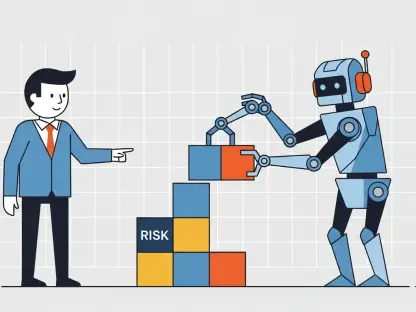In the ever-evolving landscape of cybersecurity, the holiday season emerges as a critical battleground where businesses face intensified threats from cybercriminals looking to exploit heightened online activity. As Black Friday deals and year-end shopping sprees drive a surge in digital transactions, companies find themselves under increased scrutiny from attackers eager to capitalize on vulnerabilities. A recent report from Allianz Commercial, as highlighted in industry coverage, reveals a complex picture: while large insured organizations are making notable strides in bolstering their defenses, smaller firms and uninsured entities often struggle to keep pace, particularly during this high-risk period. The question remains whether cyber insurance provides the edge needed to outmaneuver these seasonal threats or if gaps in preparedness leave too many exposed. This dynamic sets the stage for a deeper exploration into how businesses are faring against holiday-driven cyber risks and what factors are shaping their resilience in the face of evolving attack strategies.
Progress in Cyber Defense
Large Insured Companies Gaining Ground
Significant advancements in cybersecurity are becoming evident among large insured organizations, which are increasingly fortifying their defenses against digital threats. These companies have invested heavily in cutting-edge detection and response mechanisms, resulting in a remarkable 50% reduction in the severity of cyber claims and a 30% drop in the frequency of large claims during the first half of the current year. International coordination with law enforcement has further strengthened their ability to thwart attacks before they escalate. For these enterprises, cyber insurance often plays a pivotal role, mandating stringent risk mitigation measures that enhance overall preparedness. This progress reflects a growing maturity in handling sophisticated threats, positioning these firms as leaders in the fight against cybercrime, even as seasonal peaks like the holidays test their systems with increased transaction volumes and potential vulnerabilities.
Beyond technological investments, large insured companies benefit from a culture of proactive risk management that smaller counterparts often lack. Comprehensive training programs for employees, regular security audits, and robust incident response plans contribute to their resilience. These measures ensure that threats are identified and contained swiftly, minimizing financial and reputational damage. Moreover, partnerships with insurers provide access to expert resources and post-incident support, creating a safety net that allows for quicker recovery. While the holiday season brings a spike in phishing attempts and malware campaigns targeting consumer data, these organizations are better equipped to handle the influx, leveraging their enhanced capabilities to maintain stability during periods of heightened risk. This disparity in readiness underscores a critical divide in the cybersecurity landscape that becomes even more pronounced during peak times.
Holiday Season as a Stress Test
The holiday season, particularly around events like Black Friday, serves as a rigorous stress test for corporate cybersecurity frameworks across industries. With online shopping reaching its annual peak, the volume of transactions and sensitive consumer data flowing through digital channels creates a fertile ground for cybercriminals. Attackers often ramp up efforts with tailored phishing schemes and ransomware campaigns designed to exploit distracted or overworked staff. For many businesses, this period reveals weaknesses in their defenses, as the pressure to maintain uptime and customer trust can lead to lapses in vigilance. The stakes are especially high for retail sectors, where a single breach during this critical sales window can result in significant revenue loss and long-term damage to brand reputation, amplifying the need for robust protective measures.
Compounding the challenge, the holiday rush often strains IT resources, leaving systems more vulnerable to exploitation. Smaller firms, in particular, may struggle to monitor threats effectively while managing increased operational demands, making them easy targets for attackers seeking quick gains. Data from recent analyses shows a marked uptick in cyber incidents during this time, with consumer data exposure being a primary concern. Larger insured companies, while better prepared, are not immune to these seasonal pressures, as sophisticated attackers continuously adapt their tactics to bypass even the strongest defenses. The convergence of heightened activity and evolving threats during the holidays underscores the importance of preemptive planning and real-time response strategies to safeguard against disruptions that could derail both business operations and customer confidence.
Evolving Threats and Vulnerabilities
Ransomware’s Persistent Dominance and New Tactics
Ransomware continues to reign as the most pervasive and costly cyber threat, driving a staggering 60% of large claim costs for insured companies. This menace shows no signs of abating, particularly during the holiday season when businesses are under pressure to maintain operations. Attackers have refined their approach, increasingly employing “double extortion” tactics that combine data encryption with theft. In the first half of the current year, 40% of large cyber claims involved data exfiltration, a significant jump from previous periods. This evolution means that even if a ransom is paid to unlock systems, stolen data can still be leveraged for further extortion or sold on the dark web, compounding financial and reputational damage at a time when consumer trust is paramount for holiday-driven revenue.
The financial toll of these advanced ransomware strategies is staggering, with the global average cost of a data breach nearing $5 million, fueled by stricter privacy regulations that impose hefty fines for non-compliance. During peak holiday times, the impact is magnified as businesses face intense scrutiny from both customers and regulators. Retailers, for instance, become prime targets due to the sheer volume of personal information processed during sales events, making a breach not just a technical failure but a public relations crisis. Cybercriminals exploit this urgency, knowing that companies may prioritize quick resolution over long-term security fixes. As attack methods grow more sophisticated, the need for comprehensive backup systems and rapid incident response becomes critical to mitigate losses and maintain operational continuity amidst seasonal chaos.
Smaller Firms and Regional Targets Under Siege
Smaller and mid-sized companies are increasingly finding themselves in the crosshairs of cybercriminals, especially during the holiday season when their limited resources are stretched thin. Unlike larger insured entities, these businesses often lack the budget for advanced cybersecurity tools or dedicated IT teams, making them softer targets for attacks like ransomware. Recent data highlights a stark contrast: while only 39% of data breaches at large firms involve ransomware, the figure skyrockets to 88% for smaller enterprises. This vulnerability is particularly acute during high-traffic periods when online sales spike, and attackers know that smaller firms may prioritize customer service over security updates, leaving gaps that can be easily exploited with devastating consequences.
Geographically, regions such as Asia and Latin America are also seeing a surge in targeted attacks, driven by disparities in cybersecurity maturity and regulatory frameworks. In these areas, many businesses operate with outdated systems or minimal defenses, creating opportunities for cybercriminals to strike, especially during the holiday rush when global commerce peaks. The shift in attacker focus to these less-protected entities reflects a strategic pivot toward exploiting weaker links in the digital ecosystem. For smaller firms in these regions, a single holiday-season breach can be catastrophic, wiping out profits and eroding customer trust. This growing trend emphasizes the urgent need for accessible cybersecurity solutions and insurance options tailored to the unique constraints of smaller players in less cyber-mature markets facing seasonal threats.
Role of Cyber Insurance and Industry Impact
Insurance as a Resilience Booster
Cyber insurance has emerged as a cornerstone for building resilience against digital threats, offering a crucial buffer for companies navigating the perilous holiday season. Beyond mere financial compensation, insurance policies often require firms to implement rigorous risk mitigation practices, fostering a proactive approach to cybersecurity. In markets like Germany, insured companies have experienced a 70% increase in loss impact over recent years, a figure dwarfed by the 250% surge in cybercrime costs for the broader market. This gap illustrates how insurance not only cushions the blow of an attack but also equips businesses with tools and expertise to prevent incidents, a factor that proves invaluable when cyber activity spikes during festive periods with heightened online engagement and potential vulnerabilities.
Additionally, the support provided by cyber insurance extends to incident response, ensuring that businesses can recover swiftly from attacks that often peak during holiday sales events. Insurers frequently offer access to forensic experts, legal counsel, and crisis management teams, which help minimize business interruption—a cost that accounts for over 50% of cyber claim values. For insured firms, this comprehensive assistance translates into a competitive edge, enabling them to maintain customer trust and operational stability even under seasonal strain. However, with market penetration still relatively low, many companies remain unprotected, highlighting a critical need for broader adoption of insurance solutions to close the resilience gap and safeguard against the sophisticated threats that surface during high-stakes holiday windows.
High-Risk Industries in the Holiday Spotlight
Certain industries, notably retail, manufacturing, and professional services, face disproportionate risks from cyber threats, a reality that becomes starkly apparent during the holiday season. Retail, for instance, ranks among the most targeted sectors, accounting for 9% of large cyber claims by value over recent years. The industry’s high revenue, vast troves of personal data, and extensive attack surface—spanning numerous staff, suppliers, and IT systems—make it a prime candidate for extortion demands, especially during peak shopping events like Black Friday. A breach at this time can disrupt sales and tarnish brand loyalty, amplifying the urgency for robust defenses tailored to handle the unique pressures of holiday-driven digital traffic and consumer expectations.
Manufacturing and professional services also grapple with significant vulnerabilities, driven by their reliance on complex digital systems and interconnected supply chains. Manufacturing accounts for 33% of large claims, while professional services contribute 18%, reflecting the high stakes of protecting sensitive operational data and client information. During the holidays, when many firms push for year-end deliverables, the risk of social engineering scams and technical failures rises, compounding traditional attack vectors like ransomware. These sectors must prioritize cybersecurity investments and insurance coverage to navigate the expanded risk landscape, ensuring they can withstand the intensified threats that emerge during this critical period and maintain trust across their ecosystems.









